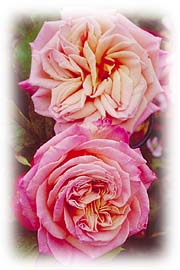|
Plant orphansby AMY STEWART
AS YOU MAY KNOW, I'VE BEEN PROMISING for a couple of months now to write something about plant orphans, those lost and abandoned plants that all gardeners take in and nurture back to health. It seemed like a good counterpoint to all the flower theft stories that came pouring in during the spring. But ironically, my own plant
orphan story is inextricably tied to the flower theft issue.
Last year, as I was walking home from lunch, I found a brilliant
blue lobelia in the gutter a couple of blocks from my house.
It wasn't in a pot, but the roots were wrapped around the soil
in precisely the shape of an ordinary clay pot. I looked around
and couldn't see any garden nearby where this plant might belong.
It seemed to have been abandoned. It was a rainy day; if I left
it where it was, it would wash into the gutter. I picked it up
and brought it home, and it's blooming on my porch right now. [Pure Mystery" photo courtesy Amity Heritage Roses.] A few months later, the same thing happened. I found a pink and white fleabane in almost the same spot, its roots curved around the soil in the shape of a shallow, round planter. I'd been meaning to plant some fleabane between my lavender plants, so I brought it home and planted it. Not long after, my neighbor called me over. "Forget flower theft!" she said. "What about flower pot theft?" Turns out she'd had several expensive stone urns stolen from her front porch. "They don't even want the plants," she said. "Look. They dumped the flowers and all the dirt out right here in my lawn and just took off with the pot." Sure enough, there was a bunch of pansies facedown in her yard. Their roots held the precise shape of the stolen pot. Suddenly I knew where my plant orphans had come from. They were stolen goods -- or innocent bystanders to another, perhaps worse, crime. But most of the plant orphan stories I've received from readers did not have such a sinister side to them. Connie Miller wrote to tell me that she gives away orphans, putting her unwanted plants up for adoption at the end of her driveway, where they usually find a new home within an hour. (She gave me her address, but I am not going to share it with you. You'll have to find your own orphanages.) I also heard from Jerry Davis, who has collected an astonishing array of orphans, including ornamental yucca and agave from his father's house, and an Italian stone pine that the postal union gave him when his father died. He's got chasteberry and monkey grass from the zoo where he used to work, and an unknown species of salvia that his father brought him from "somewhere in California." Tracy and Janet Sclar of Amity Heritage Roses in Hydesville contacted me to tell me about an orphaned rose they have propagated and listed in their catalog. Dubbed "Pure Mystery," they discovered the plant with the blended pink, apricot and gray blooms while unpacking from a move. "We've checked with all the friends/helpers whom it could have come from, but no one claims it," they say. If you'd like to find out more about that rose or any of the others that Tracy and Janet grow, check them out on the web at www.amityheritageroses.com or send an envelope with two stamps to AHR, P.O. Box 357, Hydesville 95547. Several people wrote to tell me that they swap plants back and forth between their friends and family. One friend told me the story of a philodendron that has passed from friend to friend and been propagated several times along the way. Another woman told me that she gives plants to her daughter with the expectation that she will show some sign of the family green thumb; when the plants wilt and die, she takes them home, nurses them back to health, and returns them to her, full of hope. She writes, "Sometimes friends move away and give me plants to care for as they always will return at a later date to retrieve them. Most often they do not. I can no longer tell the difference between those and the ones I bought. It's funny how adoptions lose their meaning over the course of a lifetime and become an integral part of the family, as if they belonged there all along." I couldn't have said it better myself. GARDEN FOOTNOTES: It's a great day for the Humboldt Botanical Garden Foundation: They have just broken ground at their site at College of the Redwoods. There are all kinds of treats in store there this fall -- for instance, Loleta Cheese Factory's Humboldt Garden Cheddar is for sale now at the factory in a 2-pound round, and proceeds benefit the garden. The foundation will also hold its annual symposium on Nov. 1; the subject is Mediterranean plants and you can make a reservation by calling 442-5139. Stop by the Humboldt State University's Natural History Museum for a Garden Insects Workshop with entomologist Pete Haggard. You'll learn more about the bugs living in your garden, meet a few local insects, and visit Redwood Roots Farm in Bayside to identify insects in the soil and on the plants. Round up a few of the bugs in your own garden and Pete will tell you whether you should encourage them to set up camp or squash them like -- well, like a bug. It all happens on Sept. 7, a Sunday, from 1 to 4 p.m. The cost: $10 or $8 for members. garden-related announcements and news to Amy Stewart. IN THE NEWS | COVER STORY | PUBLISHER | GOOD NEWS | CALENDAR © Copyright 2003, North Coast Journal, Inc. |


